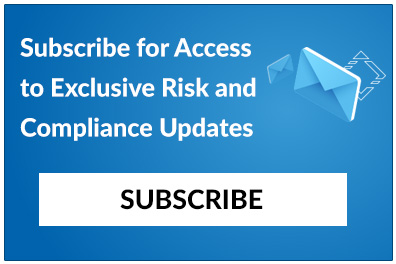Home/ Blog / Proactive Risk Management in an Evolving Regulatory Landscape
The regulatory landscape is transforming at an escalated pace, with 84% of Chief Compliance Officers (CCOs) expecting heightened regulatory expectations and scrutiny over the next two years. This acceleration is not isolated to one region or sector, as data privacy laws, such as the GDPR, and evolving ESG mandates worldwide are driving organizations everywhere to navigate a complex and expanding web of compliance requirements. At the same time, pressures from customers, investors, regulators, and public sentiment continue to intensify, leaving no room for satisfaction.
This blog provides actionable insights for businesses seeking proactive risk management in the face of evolving regulations. Rather than reacting to compliance challenges after they arise, organizations must build anticipatory strategies that integrate compliance into their core operations and decision-making processes. Leveraging data analytics, investing in emerging technologies, and fostering a culture of continuous improvement can enable businesses to stay ahead of regulatory shifts.
In a world where extreme non-compliance costs include hefty fines, reputational damage, and even loss of stakeholder trust, proactive risk management is no longer optional. It is essential for banks’ and financial institutions’ resilience, long-term success, and sustaining the trust of stakeholders in an increasingly complex environment.
The Evolving Regulatory Landscape
The regulatory environment is evolving rapidly, shaped by technological innovation, geopolitical tensions, and economic uncertainty. Advances in AI, automation, and data analytics are prompting the development of new regulations surrounding data privacy, cybersecurity, and algorithmic transparency, such as the provisional EU AI Act and stricter FTC data privacy guidelines. Simultaneously, global crises, such as the Ukraine conflict, have led to sweeping sanctions, while ESG mandates are rising as nations pursue net-zero goals and greater supply chain accountability.
In the U.S., the SEC’s proposed rules on cybersecurity and climate disclosures signal an increased focus on operational transparency. Meanwhile, Asia prioritizes anti-fraud initiatives and strategies to counter terrorist financing.
Given this fast-paced change, businesses can no longer afford to react passively. Proactive risk management strategies are essential, as they integrate foresight and agility to anticipate regulatory shifts and embed resilience across operations.
Key Strategies for Effective Risk Management
Continuous Monitoring and Assessment
Establishing robust monitoring systems is essential for effective risk management in a competitive environment. Continuous monitoring enables organizations to detect compliance breaches or vulnerabilities early before they escalate into costly failures. According to KPMG, companies investing in data-driven tracking will stay ahead of dynamic risks, including cyber threats and evolving ESG obligations. Regular risk assessments should not be static exercises; they must incorporate real-time data and predictive insights to identify emerging risks proactively. Advanced analytics can identify unusual patterns, enabling compliance teams to respond swiftly to fraud, money laundering, or policy breaches. By embracing technologies that deliver actionable insights, businesses can prioritize high-risk areas, streamline reporting, and maintain a flexible and agile compliance posture, ultimately leading to proactive risk management.
Agile and Adaptive Risk Frameworks
Risk management frameworks must be flexible and scalable to remain effective despite evolving risks and regulations for banks and financial institutions. Static, one-size-fits-all approaches no longer suffice. Instead, organizations should embed agility into risk management by incorporating scenario planning and stress testing into their assessments. These proactive techniques enable businesses to anticipate potential disruptions, assess their impacts, and develop contingency plans accordingly. The value of integrating regulatory considerations early in product development and business processes lies in building resilience from the outset. Cross-functional collaboration is equally critical. Proactive risk management cannot operate in silos; it requires alignment across compliance, legal, IT, finance, and operations. By fostering collaboration, companies can understand risks comprehensively and improve decision-making throughout the organization.
Leveraging Technology and Data
The rise of RegTech and automation is transforming risk management processes. Tools that automate regulatory change tracking, compliance monitoring, and reporting drastically reduce manual workload and improve accuracy. KPMG’s report highlights how companies increasingly invest in technologies such as predictive analytics, bots for repetitive tasks, and AI-driven insights. Data analytics is pivotal in revealing risk patterns, tracking compliance metrics, and delivering real-time dashboards for leadership visibility. However, with this reliance on data comes an equally important need for strong data privacy and security protocols. Companies must adopt a “privacy-by-design” approach, embedding safeguards into every layer of technology implementation to protect sensitive information, comply with regulations, and ensure proactive risk management.
Investing in Talent and Training
Technology alone is not enough; a skilled workforce remains at the heart of effective risk management. According to KPMG, 72% of companies plan to increase their staff, indicating that organizations recognize the need to build internal expertise. Ongoing training ensures that employees remain informed about evolving regulations and are equipped to manage new risks. Beyond technical knowledge, a culture of risk awareness across all levels of the organization fosters shared accountability. Embedding tools and tech of generative AI in financial services leadership evaluations and performance reviews reinforces this culture, ensuring that risk management becomes an organizational priority rather than a task solely for the compliance department.
Stakeholder Engagement and Communication
Maintaining communication with regulators, investors, and key stakeholders is essential for building trust and ensuring proactive risk management. Transparent reporting and timely disclosures fulfill regulatory obligations and strengthen an organization’s reputation. KPMG advises businesses to engage proactively with regulators, keeping them informed of compliance efforts and responding promptly to inquiries or audits. Regular, clear communication reassures stakeholders that the organization takes compliance seriously and is committed to ethical business practices. Strong relationships with regulators can also provide valuable insight into upcoming regulatory changes, enabling businesses to prepare in advance and maintain their competitive edge.
Practical Implementation and Best Practices
Proactive risk management demands more than just a strategy; it requires disciplined execution. Assessing the impact of regulatory changes is the starting point, enabling businesses to understand the implications for their operations, systems, and risk exposure. This ensures proactive adjustments before issues arise.
Next, companies must consistently update their policies and procedures to reflect evolving regulations and business realities. Clear ownership and regular reviews help maintain alignment and prevent gaps in the alignment.
Employee training is equally vital. Tailored, continuous education fosters a culture of regulatory management, empowering staff to recognize risks early and reinforcing accountability through performance metrics.
Lastly, ongoing maintenance ensures that proactive risk management programs remain resilient. Routine audits, monitoring, and updates ensure frameworks remain responsive to new threats and regulatory developments. By treating compliance as an evolving practice, organizations not only fulfill their legal obligations but also enhance their operational integrity and foster trust among stakeholders.
Implementation of Generative AI-Powered RCM Software
To stay ahead in an increasingly complex regulatory landscape, businesses require advanced tools that seamlessly integrate automation, intelligence, and usability. Predict360 Regulatory Change Management (RCM) Software delivers precisely that. Combining real-time regulatory intelligence, automated change tracking, and impact assessments with generative AI in financial services enables more effective management of regulatory change. Users receive instant updates from diverse regulatory sources, intelligent parsing of changes, and automated assessments that highlight which business units, policies, and procedures are impacted, all within a unified platform.
Kaia RCM and Risk & Performance Insights
Kaia, Predict360’s AI-powered companion, offers a transformative leap in proactive risk management, regulatory change, and performance insights. Kaia can review regulations based on regulatory data feeds of new and upcoming legislation, highlighting how business policies and processes will be affected. Users can also query and get suggestions on how processes and policy documents can be aligned with new regulations.
Request a Demo
Complete the form below and our business team will be in touch to schedule a product demo.
By clicking ‘SUBMIT’ you agree to our Privacy Policy.



